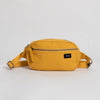Table of Contents
As the global fashion industry grapples with its environmental and social repercussions, the concepts of regenerative fashion and sustainable fashion have emerged as potential solutions. While both aim to address the pressing issues within the fashion ecosystem, they differ in their approaches and objectives.
Let's look at the key differences between regenerative fashion and sustainable fashion, shedding light on their unique contributions to creating a more responsible and conscious industry.
What is Sustainable Fashion?
Sustainable fashion focuses on reducing the negative environmental and social impacts of the fashion industry. It aims to maintain a balance between meeting current needs and preserving resources for future generations. It embraces practices that minimize waste, reduce carbon footprint, and promote ethical labor standards. Sustainable fashion also emphasizes responsible sourcing of materials, energy-efficient production processes, and circular fashion models to extend the lifespan of clothing items. Sustainable fashion also recognizes the importance of social responsibility. Ethical labor practices, fair wages, and safe working conditions for garment workers are integral components of sustainability.
Brands adopting sustainable practices prioritize sustainable materials like organic cotton and recycled fibers, recycling, upcycling, etc. By cutting down the consumption of new resources and extending the life of products, they strive to lessen their environmental footprint. Conscious brands also foster transparency and accountability throughout their supply chains, ensuring that all stakeholders are treated fairly and with respect.
What is Regenerative Fashion?
Regenerative fashion takes sustainability a step further by actively seeking to restore and replenish the environment through fashion practices. This concept is rooted in the idea of "giving back" to nature rather than merely minimizing harm. Regenerative fashion goes beyond reducing negative impacts and strives to create a net-positive effect on the environment and communities.
At the heart of regenerative fashion lies the principle of regenerative agriculture. The practice focuses on enriching the soil, enhancing biodiversity, and sequestering carbon. By adopting regenerative farming methods, such as no-till farming, cover cropping, and rotational grazing, fashion brands can actively contribute to restoring soil health and mitigating the effects of climate change. Regenerative fashion also prioritizes the role of carbon sequestration. Beyond sustainable fashion's aim for carbon neutrality, regenerative fashion seeks to become carbon positive. This means that the fashion industry actively sequesters more carbon than it emits, effectively making a positive contribution to combating climate change.
What are the Key Differences?
1. Approach to Environmental Impact
- The primary focus of sustainable fashion is to minimize the environmental impact of the fashion industry by adopting eco-friendly practices and reducing resource consumption. Sustainable brands prioritize reducing greenhouse gas emissions, water usage, and waste generation.
- In contrast, regenerative fashion is not just about minimizing harm but strives to actively replenish the environment and restore all ecosystems.
2. Focus on Circular Economy
- Sustainable fashion places a strong emphasis on circularity– less waste, more usage. Sustainable brand practices prioritize recycling, upcycling, and using eco-friendly materials to create a closed-loop system.
- Regenerative fashion may also embrace circular practices, but the primary focus is on creating positive impacts on the environment and communities through regenerative approaches like regenerative agriculture.
3. Impact on Biodiversity and Ecosystems
- Sustainable fashion acknowledges the importance of preserving biodiversity and ecosystems but may not necessarily focus on active restoration efforts. Sustainable brands prioritize responsible sourcing and reducing environmental harm, but their actions may not always include active ecological restoration.
- Regenerative fashion zooms the lens on restoring and enhancing natural ecosystems and their biodiversity. By adopting regenerative agricultural practices, brands can proactively contribute to improving soil health and supporting wildlife habitats.
4. Community and Social Impact
- Both sustainable and regenerative fashion acknowledge the importance of ethical labor practices and social responsibility. Brands committed to sustainability prioritize fair wages, safe working conditions, and transparency throughout their supply chains.
- Regenerative fashion places additional emphasis on empowering communities and supporting local economies. It fosters regenerative agricultural practices that benefit farmers and local inhabitants. By contributing to environmental restoration, regenerative fashion can also positively impact communities by creating resilient and sustainable ecosystems.
Conclusion
As fashion evolves towards more responsible practices, sustainable fashion and regenerative fashion play crucial roles in reshaping the future of the industry. Both concepts offer valuable contributions to transforming the fashion industry into one that prioritizes ecological integrity, social equity, and conscious consumerism. By understanding the key differences between regenerative and sustainable fashion, consumers can make informed choices and support initiatives that align with their values, contributing to a more sustainable and regenerative future for fashion. Ultimately, by embracing both sustainable and regenerative practices, the fashion industry can take significant steps towards a more responsible, resilient, and thriving future for the planet and its inhabitants.
At Terra Thread, we are practicing both approaches. Currently, all of our products are made with organic cotton in Fair Trade Certified factories. Earlier in 2023, we launched our first collection of clothing made with Regenerative Organic Cotton. We plan to transition all of our products to regenerative organic cotton in the coming years.
Related blog:
What is ethical fashion?
Truth about sustainable fashion.
What is slow fashion?




